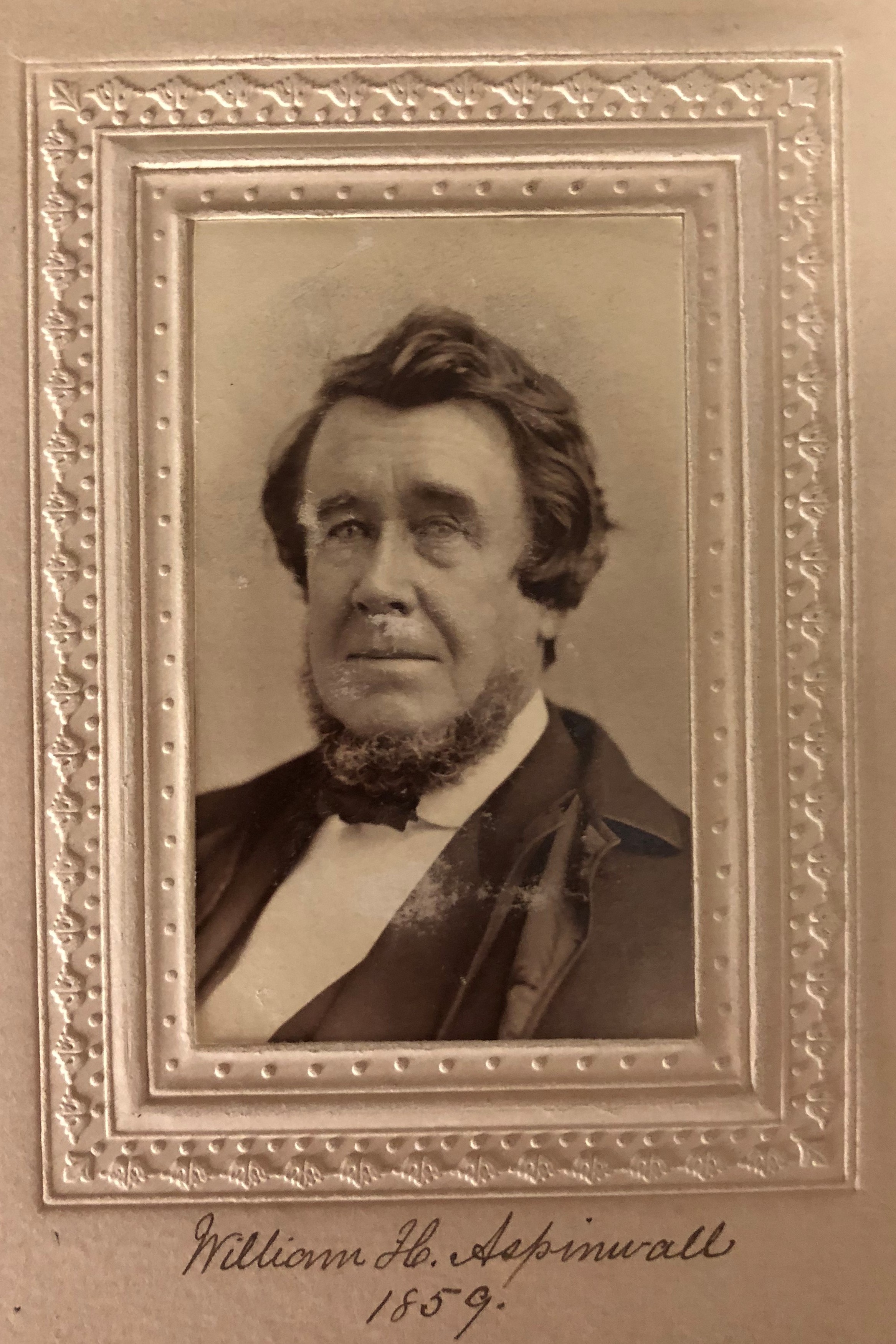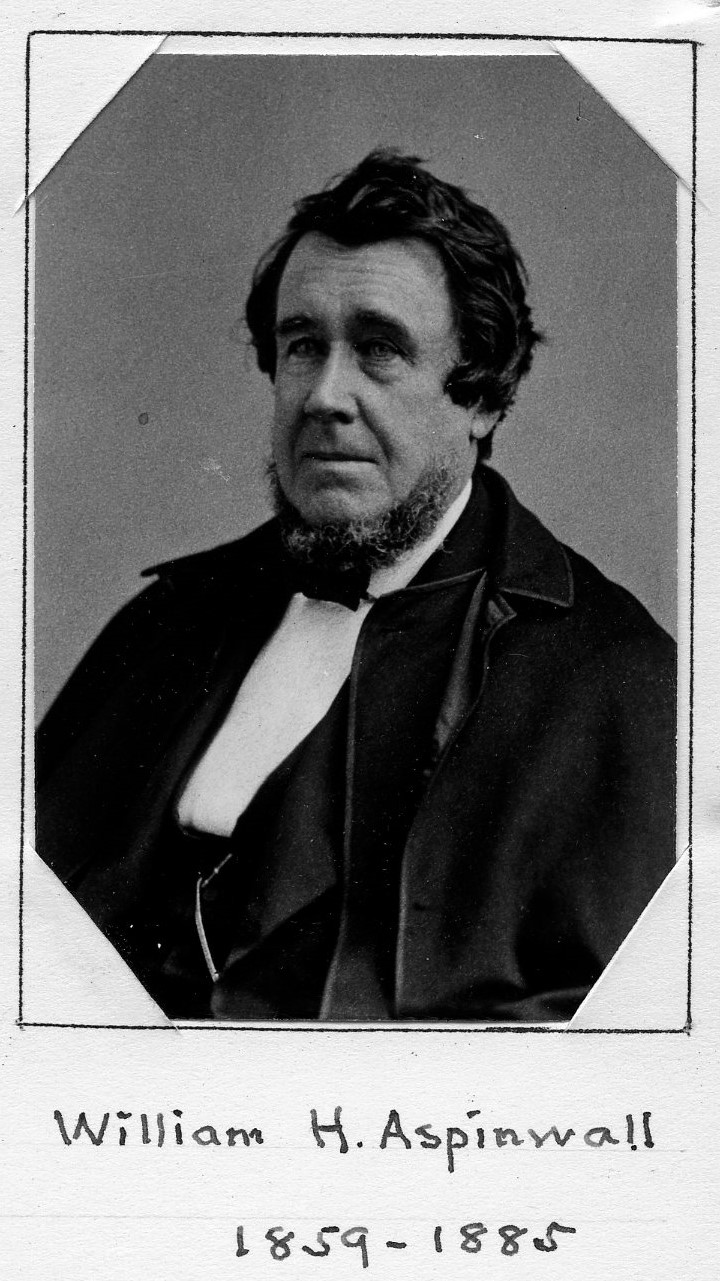Merchant Shipping
Centurion, 1859–1875
Born 16 December 1807 in New York (Manhattan), New York
Died 18 January 1875 in New York (Manhattan), New York
Buried Green-Wood Cemetery , Brooklyn, New York
, Brooklyn, New York
Proposed by Peter R. Strong
Elected 4 June 1859 at age fifty-one
Archivist’s Note: Father-in-law of James Renwick Jr.; uncle of James Roosevelt; great-uncle of James R. Roosevelt and Franklin D. Roosevelt
Century Memorial
What couldn’t William Henry Aspinwall do? Shipowner, merchant, agent for the Union during the Civil War, builder of the first clipper ship, builder of the Panama Railroad, founder of the Society for the Prevention of Cruelty against Animals, founder of the Metropolitan Museum of Art, diplomat, benefactor, Centurion.
Admirers and critics wondered if he was astute, lucky, or clairvoyant.
Exhibit A. Astute. Foreseeing increased trade with China after the First Opium War, in 1843 he contracted with the Smith & Dimon yard on East 4th Street to build the first clipper ship, designed by John Willis Griffith, for $50,000. The ship, Rainbow, followed by Sea Witch, set the record under sail from China via Cape Horn (seventy-seven days—the record still stands). The cargos included tea, silk, and opium.
Exhibit B. Lucky or Clairvoyant? California was not yet a state when in 1845 Congress announced it was taking bids on mail contracts, including one from Panama to the Oregon Territory, including California. This was the least appealing of the offerings but, after some bargaining, Aspinwall acquired it. His commercial acquaintances called it a “very poor bargain” and questioned his heretofore infallible mercantile instincts.
To fulfill the contract, in 1848 Aspinwall incorporated the Pacific Mail Steamship Company and ordered three steam-driven ships (a government requirement): the California, the Panama, and the Oregon. He also secured the rights to build a railroad across the Isthmus of Panama. Then, in 1849 . . . gold was discovered in California. On its maiden voyage around the Horn, the California, unaware of the gold strike, pulled into Panama to refuel and was deluged by hundreds of miners desperate for passage to San Francisco. Aspinwall’s ships supplied the men and materials for the Gold Rush and brought the gold back to New York. Clairvoyant? Lucky?
To build the Panamanian railroad, Aspinwall selected the right engineers, raised the funds, and kept matters on track through unimaginable obstacles—swamps, crocodiles, mosquitoes. It took five years, the lives of 6,000 men, and $8 million to do it, but in 1855 the very-profitable, forty-seven-mile Panama Railway opened. The town at the Atlantic terminus of the railroad was named Aspinwall, until the Colombians renamed it Colón. A monument to Aspinwall stands in Colón to this day.
He was a man to be reckoned with, yet public-spirited and charitable. When Lincoln stopped in New York en route to his inauguration, he dined with Aspinwall and several other tycoons. Unimpressed, Aspinwall called Lincoln “airy.” As matters deteriorated in Charleston, Aspinwall, together with John Forbes, proposed a stealth mission to reinforce Ft. Sumter with men and ammunition, using Aspinwall ships posing as cotton traders. Edwin Stanton, the secretary of war, was in favor, but the Navy got its back up and insisted on using its ships for the mission, thereby leading to Stanton’s scuttling the plan.
In 1863, Aspinwall and Forbes were delegated by Treasury Secretary Salmon Chase and Navy Secretary Gideon Welles to travel to England to prevent their shipyards from building ironclads for the Confederate Navy. Aspinwall and Forbes spent three months in England, negotiating with government officials and the shipyards—one plan being to buy the ships under construction—and stealthily enlisting public opinion against the Confederate ships being allowed to go to sea. Eventually, the British government seized the ships.
Aspinwall, like many other New York businessmen, supported General McClellan for president in 1864. After he heard that McClellan had voiced opposition to the Emancipation Proclamation, Aspinwall journeyed to Antietam, gave McClellan a dressing-down, and told him to support the president. After the war, Aspinwall helped buy homes for both McClellan and General Sherman.
William H. Aspinwall was descended from a family of mind-boggling connections. His Howland ancestors came on the Mayflower and were major shipowners in the sugar and slave trades before the Revolution. One of Aspinwall’s sisters became the grandmother of Franklin Delano Roosevelt. Aspinwall married Anna Breck, whose father had been a member of Congress from Pennsylvania. They had four children.
Over his life, he traveled to Europe and acquired paintings, which included: Murillo’s The Immaculate Conception, Velasquez’s Portrait of a Knight of Malta, Titian’s Herodias with the Head of John the Baptist and Portrait of Paul III, and da Vinci’s Profile of Our Savior. He also owned Gilbert Stuart’s Portrait of George Washington, painted for James Madison, and Frederic Church’s The Beacon on Mt. Desert Island, Maine. He built his own picture gallery, designed by his son-in-law, James Renwick, Jr., and opened it to the public certain days of the week.
In 1869, he helped found the Metropolitan Museum of Art, his name being fifth on the list on the tablet in the Great Hall of the Museum.
He was a pious man and was superintendent of the Sunday school at St. John’s Episcopal Church on Staten Island and at his death was president of the American Church Missionary Society.
The only charitable solicitation that he was known to have refused was from Columbia University to establish a School of Mines. “Fund it out of your endowment” was Aspinwall’s reply.
He relished being with his family at his country estates in Staten Island and Tarrytown (this latter property is now part of the Rockefeller estate). Punctilious in manners, when spying a grandchild with elbows on the table, he would say, “Shall I send for a book to support your elbows?”
He was nominated to the Century by the poet Peter R. Strong in 1859. He died on January 18, 1875, at his home on University Place at age sixty-seven. Somehow he was missed in the club’s necrology for that year.
The Sacramento Daily Union said at his death: “He was one of the merchant princes of the age; one of those—unlike the modern politicians—whose whole conduct was guided by the principles of truth and honesty, and who would sooner cut off his right hand than sell his soul for filthy lucre. We fear that such men are dying off, and few will be found to fill their places.”
Alexander Sanger
2019 Century Association Yearbook


